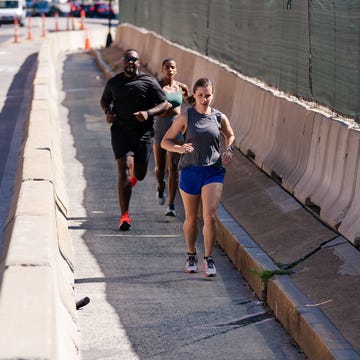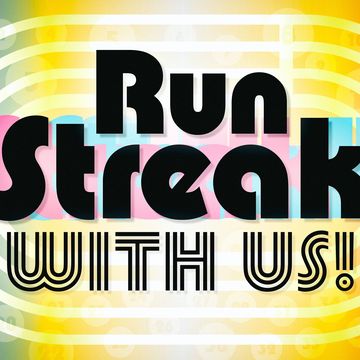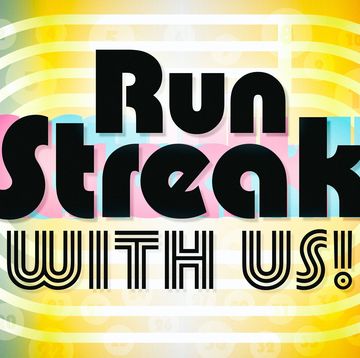The Run Streak centers on the mile, which, in our humble opinion, is an underappreciated distance. “I love it,” says Runner’s World coach Jess Movold of the mile. “It’s the perfect distance to get you going.”
Whether you’re a new runner building up to your first-ever mile, an experienced athlete training for a fast 1600 meters, or a middle-of-the-pack runner just looking to fit a little more movement in your day, there’s a lot to love about this distance. Here, 15 amazing benefits of a one-miler.
Join the #RWRunStreak! Receive helpful tips directly to your inbox.
More From Runner's World

1. You can reap serious benefits in a short amount of time
Think the mile is too short to provide legit health benefits? Not true. When it comes to exercise, every bit counts. In fact, research shows that just 10 mins of running can boost your mood. Moreover, running in 10-minute bursts consistently can raise your VO2 max, lower your heart rate, and even help you build muscle. That’s a lot to gain from a relatively short distance.
2. It’s proof you don’t need to run long to be a runner
There’s a misconception in the running world that you have to log a certain number of miles in order to be a “runner” or for a run to “count.” Truth is, “that’s absolutely not the case,” says Movold. “One mile is a run. There’s a start, there’s a middle, there’s a finish. One mile offers a sense of accomplishment and is a complete effort.”
In fact, building up to run continuously for a mile is a “big goal” for a lot of first-timers, says Janet Hamilton, certified strength and conditioning specialist, exercise physiologist, and running coach with Running Strong. If that’s your goal throughout the run streak, you’re 100% a runner.
3. The mile is less intimidating than long distances
The mile is just four quick laps around the track, which is a lot more achievable, and way less daunting than logging, say, 26.2 miles for a marathon, or even 3.1 miles for a 5K.
4. You can do it every day
Most of us don’t have the time or physical ability to run long distances every day—nor would many experts recommend that as part of a safe and well-rounded training plan. But a mile? Now that’s a distance you can repeat day in and day out, so long as your body is telling you you can handle it and you’re not going max effort each time.
5. The mile is easy to fit into your schedule
Finding time to run a 10K or even a 5K isn’t always feasible with busy schedules. A mile, however, is much easier to slot in: It takes just a small chunk of your time—say, a quarter of your lunch break—and still provides a lot of the amazing benefits of running. By logging a mile, says Movold, “your day is going to be that much better.”
6. You don’t need to worry about fueling
When you’re only running a mile, there’s no need to pack a water bottle or mid-workout snacks, making it that much easier to just lace up and get out the door. The fact that no fuel is needed can be an extra plus for runners who struggle to stomach food while striding. The mile, says Movold, is “so simple, which is the beauty of it.”
7. The mile is a realistic goal for a wide range of runners
Not everyone has the bandwidth, ability, or desire to train for a long-distance race. The mile, on the other hand, is a “great goal,” says Nicole Sifuentes, certified strength and conditioning specialist, two-time Olympian who specialized in the metric mile, and running coach with Sifuentes Coaching. “It’s certainly more appropriate than the big goal of the marathon for a greater number of people.”
8. It’s really versatile
There are loads of ways to approach the mile. You can run it all out for time, jog it at a slow pace for recovery, or tackle it at a specific pace, says Hamilton. That means it can help you turn up the challenge if you’re in the mood for fast, simmer it down if you’re in the mood for slow, or find that perfect middle pace that allows you to practice being comfortable with a little discomfort.
9. It’s a great way to track your progress
The minimal time commitment of running one mile means it can be an easy and convenient way to track your progress. For example, every week, you could time yourself running a mile, and see how much you improve, suggests Movold. Noting those incremental improvements may just be the motivation you need to continue working toward your fitness goals.
10. Training for a fast mile requires switching up your training
Effectively preparing for a one-mile race demands a mix of easy running, sprinting, and “everything in between,” says Sifuentes. In this sense, a mile training program is more varied than, say, marathon training, where runners often steer clear of sprinting and super high-intensity efforts. The diversity of mile training can appeal to runners who get bored easily, or those who simply enjoy mixing things up.
11. It can seriously improve your fitness
As we mentioned, training for a mile involves high-intensity speed work, which, depending on how you structure it, can qualify as high-intensity interval training (HIIT). Regularly incorporating HIIT into your routine can deliver a ton of benefits, including weight loss, improved brain health, and boosted speed and performance, as Runner’s World previously reported.
12. You’ll save loads of time
Preparing to race a mile demands fewer hours of your schedule than training for longer distances, like a half or full marathon. “The time commitment can be quite low,” says Sifuentes, making it ideal for busy athletes who still want to test their strengths.
13. Racing the mile is seriously badass
“I have a ton of respect for athletes who race the one-mile distance,” says Hamilton. That’s because, in the mile, you’re running at your max sustainable effort for several minutes, which, quite simply, is “hard work,” explains Hamilton.
“You’ve got to get comfortable with being uncomfortable if you’re going to be a miler,” she adds.
14. You’ll get a crash course in pacing
If you’re racing a mile, you have to be really keyed into your effort level. “There are less places to hide than in the marathon or half marathon,” says Sifuentes, meaning there is less room for error. “In a longer race, if a runner accidentally starts too fast or too slow, they have plenty of time to adjust, slow down or speed up, and find their rhythm in the race,” she explains.
But in the mile? Runners often won’t realize their pacing is off until the race is more than halfway over, “at which point they will already be fading (from starting too fast), or will not have enough distance left to make up for lost time in the first half,” she explains.
Because the mile is such a short distance, you’re forced to learn the skill of pacing sooner, Sifuentes explains. “In a long race, a runner can get away with not ‘listening’ to their body and instead just checking their watch for heart rate or pace or power or whatever metric they want to follow and adjusting according to that,” she says. But in the mile, there is “no time for that kind of feedback.”
Thus, runners who race the mile can learn how to intuitively pace themselves, a skill that will greatly benefit future runs. “A runner who knows how to pace themselves well is gonna enjoy their workouts and their races more,” says Sifuentes.
15. It can help build a strong foundation for longer distances
If you focus your training efforts on running a fast mile, which will involve some of those higher-intensity efforts, you’ll be set up for success if you choose to expand to longer-distance events down the road. “When you run fast for the mile, your body’s working in a greater range of motion, it’s working at higher intensities,” says Sifuentes. “And then when you come down from that, it makes everything else feel a little bit more comfortable, and your body’s gonna manage [lower efforts] better.”













